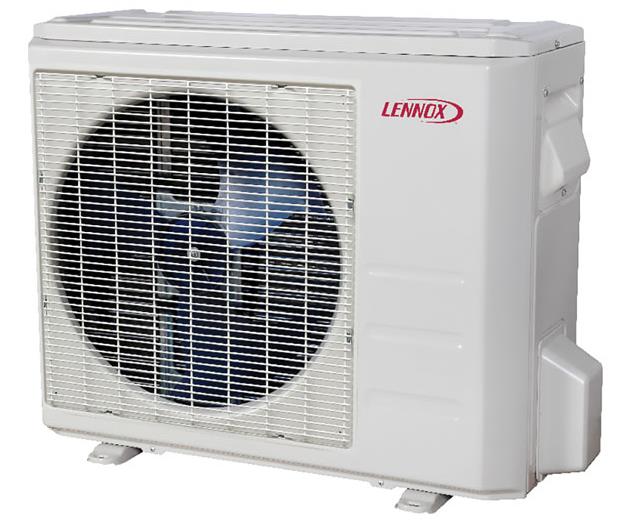
BRAND RECOGNITION:Nortek’s mini-split equipment is available in multiple brands, including the Gibson model shown here.
For nearly 20 years, The NEWS has followed the growing popularity of the HVACRmini-splitmarket. A glance into the archives shows the ductless industry in its North American infancy in 2000, when 12 SEER was the pinnacle. Today’s ductless units boast efficiency levels as high as 42 SEER.
Due to advancements in technology and efficiency and the swelling consumer awareness, ductless equipment continues to be one of the fastest-growing sectors throughout the HVACR industry.
MARKET MATURITY
Since they were first introduced in the U.S., HVACR mini-split systems have evolved exponentially. Today’s systems offer greater system capacity, longer pipe lengths, larger height separation, wider operation ranges, loftier efficiency levels, the advent of inverter-driven compressor technology, the onset of intelligent controls, and more.
Per MarketsandMarkets, the global ductless heating and cooling systems market is projected at $78.62 billion today, with a compound annual growth rate exceeding 8 percent through 2021.
“There are many uniquely different factors that contribute to the steady increase in mini-split sales, including application flexibility, high efficiencies, low sound levels, improved aesthetics, and improvements in heat pump technology,” said Doug Widenmann, senior vice president, national sales, Daikin North America LLC.
One constant trend is the steady improvement in the technology and heating capabilities of heat pumps in cold climates as well as an improved knowledge and acceptance of heat pump benefits in the northern regions
“The Daikin mini-split product development team continually looks for ways to adapt the superior technology of mini-splits to the North American ducted market applications,” Widenmann said. “Much advancement has been made in the development of advanced inverter compressors, fan motors, heat exchangers, and refrigerant control technologies that allow heat pump systems to be used in the colder climate conditions of the northern U.S. and Canada.
“Consumers and building managers have both become more aware of the increased performance and enhanced comfort provided by the latest advancements in heat pump technology to the point where it is now one of the first considerations as a potential solution for replacing or installing a new HVAC system in their homes or places of business,” continued Widenmann.
Nortek attributes the rapid growth of its ductless products to its established distribution base.
“Educating distributor personnel, contractors, and consumers has been a key factor for our ductless growth,” said Keith Clark, national sales manager, ductless VRF, Nortek Global HVAC. “Distributors can easily combine ductless equipment with conventional equipment, parts, and accessories to meet freight minimums and consolidate vendors. Consumer rebates have also been significant drivers in the Northeast and Northwest. In some cases, consumer rebates have offset a large amount of the cost to the consumer. Word-of-mouth has also been another solid driver. As people live with these systems and experience the benefits, they are telling their friends and neighbors. Consumers are amazed with the quiet operation and energy savings. As more ductless systems are installed, consumer awareness and acceptance is growing tremendously.”
Jerad Adams, director of commercial product management, Friedrich Air Conditioning Co., agrees that consumer awareness is a primary driver when it comes to ductless sales.
“There are more trained contractors, and the comfort level with mini splits as a complete HVAC solution is at an all-time high for both qualified installers and residential homeowners,” he said. “Homeowners love the fact that, with mini splits, they can customize the temperature of each room in their home. That means they aren’t wasting energy by cooling or heating rooms that are unoccupied. Prices are also beginning to come down due to greater availability, so that makes mini splits available to a greater number of homeowners.”
DESIRABLE FEATURES
Fujitsu General’s ductless mini-splits provide heating down to minus 15°F, making them a sole source for heating in most climates, said Matt Peterson, president and COO, Fujitsu General America Inc.
“Multi-zone options provide up to nine indoor units to one outdoor unit, and zoning capabilities allow for individual comfort control,” he said. “Fujitsu General systems are Wi-Fi compatible, using either built-in technology or via additional accessories. Beyond product features, Fujitsu General systems are backed by up to a 12-year warranty, and contractors have peace of mind knowing they are supported by Fujitsu’s tech service team, training programs, national advertising, and brand-building activities.

MULTIPLE CHOICES:Lennox Intl. Inc.’s portfolio of indoor ductless units includes a wall-mounted unit, ceiling cassette, ceiling- and floor-mounted options, and a medium static ducted unit.
“When selling this technology, contractors should tout the high level of comfort mini splits provide as well as the energy savings achieved from switching from an older, more traditional system to a ductless multi-zone system,” continued Peterson.
Michelle Robb, director of residential marketing, Mitsubishi Electric US Inc.’s Cooling & Heating Division, said there are many features that make Mitsubishi Electric’s mini-split equipment valuable to consumers.
“These heat pumps offer zoning capability for better comfort, efficiency, and smart control of individual spaces,” she said. “Consumers are interested in healthy indoor environments, and our systems provide constant air changeover and advanced filtration, satisfying that desire.”
Contractors benefit from the features available on Mitsubishi Electric’s equipment as well.
“There are many tools available to contractors, ranging from system design to system startup,” continued Robb. “Through Sales Builder Pro or Design System Builder, contractors can design a system while with the customers or from their office, providing a list of system components, piping design, and system pricing. These tools assist the contractor in designing and pricing the system accurately, which reduces the amount of time required in the sales process. In addition, should the owner utilize our kumo cloud app and smart devices, contractors can set up and commission systems through the app, which provides self-discovery of smart devices and easy transfer of ownership.”
When selling this technology, contractors should focus on how the advanced zoning technology provides better comfort and control, a healthier environment, and the most efficient systems available today, which saves energy and reduces environmental pollutants for cleaner living, Robb added.
Widenmann said there is becoming less of a clear line between traditional residential unitary split systems and mini-split systems, and Daikin is further blurring that line with its VRV LIFE™ system.
“Mini splits are not necessarily ductless,” he said. “Sixty percent of our mini-split installations are ducted. Combining all the higher technology features and benefits of mini splits with traditional ducted applications only makes sense. Daikin just launched its VRV LIFE product line. One of the main highlights of VRV LIFE is the inclusion of a traditional gas furnace, which is ducted, of course. The Daikin mini-split product portfolio provides many different indoor products, both ducted and ductless, that provide ultimate application flexibility to fit any application requirement.”
Brittani Youman, product marketing manager for package units and mini splits, Lennox Intl. Inc., said mini splits, also referred to as ductless systems, are easy to install and maintain.
“Mini splits help increase the speed of an installation for contractors,” she said. “The system consists of an outdoor unit, and the indoor unit is connected through a hole in the wall. This reduces the maintenance because homeowners don’t have to maintain traditional ductwork.”
Youman said Lennox offers a number of configurations, courtesy of four different types of indoor heads.
“Lennox’s portfolio of ductless mini splits includes a wall-mounted unit, which is the traditional indoor unit; a ceiling cassette, which tends to be used in more higher-end homes because it’s located out of the living space and can’t be seen on the wall; ceiling- and floor-mounted options, which are great for reading nooks; and a medium static ducted unit, which is placed behind the wall, inside existing ductwork, where it can’t be seen.”
CONTRACTOR TRAINING
As more and more consumers opt for ductless solutions, the need for qualified contractors has never been higher.
“Unfortunately, the industry still has a long way to go to get contractors engaged and properly trained on ductless products,” said Clark. “Most contractors are aware of ductless products, and many have at least some experience with training and/or installation of these products; however, ductless products still represent a relatively small share of the North American market compared to conventional equipment.”
When contractors install ductless products, they quickly become believers in the technology as they learn how easy the installation process is, Clark said.
“That said, there’s still a large number of contractors who are not embracing ductless products,” he said. “In some cases, it comes down to the fact that people are creatures of habit. You know, ‘If it ain’t broke, don’t fix it…’ But the tide is turning. They will have to embrace ductless at some point or risk missing a large chunk of business from this rapidly growing segment.”
While Adams believes training is improving, there is still significant room for improvement, he said.
“Contractors are becoming more skilled and familiar with mini splits, yet they still need resources and guidance available through online and mobile tools,” he said. “Also, the technology is continuing to evolve, so it’s important to keep up on what’s new through continued education.”
The awareness of the benefits of mini splits is increasing at all levels, and market adoption in the U.S. has grown significantly, Adams added.
“Manufacturers have done a good job driving contractor and consumer education,” he said. “What’s lacking is that traditional technical schools still aren’t focusing on ductless installation yet and are not pushing educational opportunities for this technology as a primary solution.”
Mitsubishi Electric continues to train thousands of HVAC contractors each year while operating training centers throughout the markets they serve.”
According to Robb, Mitsubishi works closely with its distributors, many of which offer training centers in their facilities. More educated consumers are driving the need for HVAC contractors to stay ahead of new technology in order to provide the best solution for consumers, she said.
“Additionally, utilities driving the need for reduced infrastructure demand and reduced carbon footprint result in a cleaner, greener environment,” Robb continued. “There are thousands of utility rebates and tax incentives available to homeowners to drive adoption of highly efficient air-source heat pumps.”
While training continues to evolve, many manufacturers insist contractors are receptive to learning more about the nuances of ductless HVAC.
“Fujitsu General offers a variety of courses based on level of experience, including online classes, in-person sales, technical training, and hands-on troubleshooting,” said Andy Armstrong, vice president of sales and marketing, Fujitsu. “Contractors are realizing that this technology is not only the future of HVAC but the present and a way to grow their businesses now.”